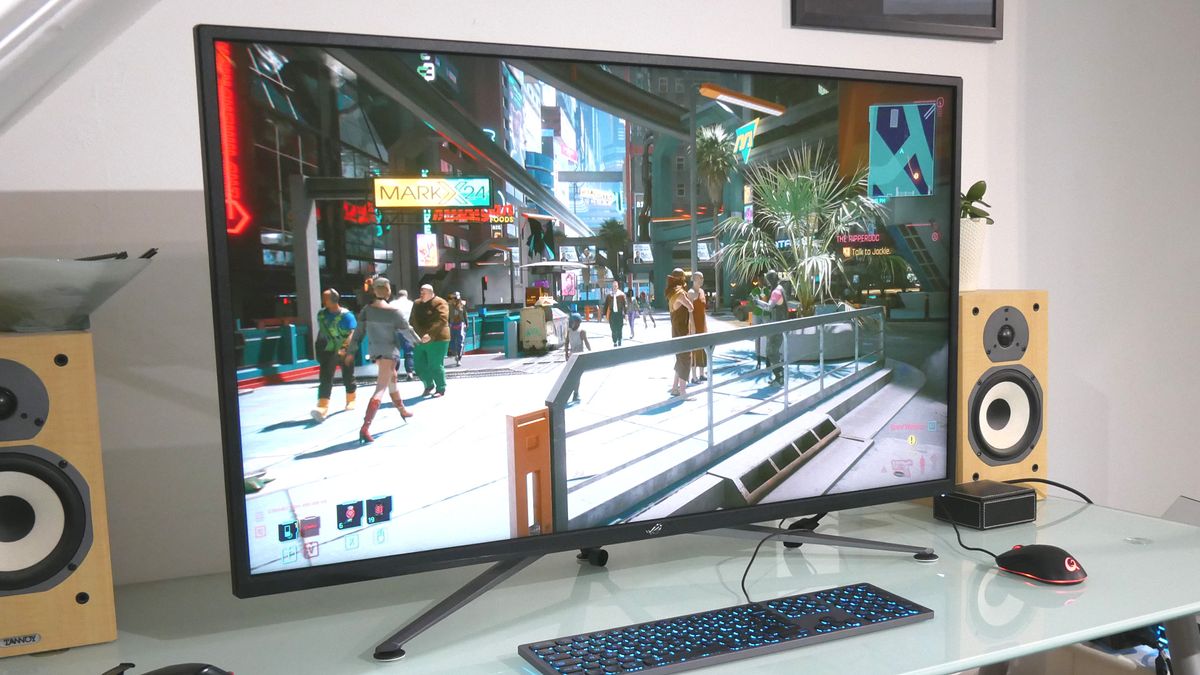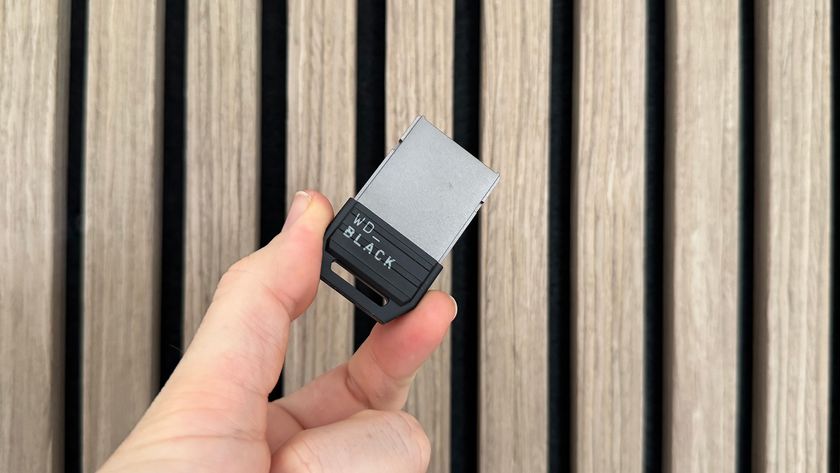12DOVE Verdict
The ASUS ROG Strix XG43UQ packs a massive HDR punch - and price tag - but is also seriously short on speed.
Pros
- +
Ridiculously bright
- +
Excellent static contrast
- +
Strong feature set
Cons
- -
Costs megabucks
- -
Disappointing pixel response
- -
Annoying image processing
Why you can trust 12DOVE
Huge 43-inch 4K panel. 144Hz refresh. 1ms response. Eye-popping 1,000 nit peak brightness. Do contenders for the best gaming monitor get any bigger, any bolder, or any better? The new ASUS ROG Strix XG43UQ certainly looks like a winner, on paper.
If anything, it could be too much of a good thing given how much desk space you’ll need to accommodate those epic 43-inch proportions. That depends on exactly what you have planned for this beast, of course. As a pure PC monitor, the size of this 4K gaming monitor could be an issue. If console gaming is in the mix, things could be different. And, yes, if you’re wondering, the XG43UQ does support HDMI 2.1, so it will do the full 120Hz job at 4K to be a potential winner as best PS5 monitor or best PS4 monitor, as well as play nice with Microsoft's latest game box, too.
The stock of this monitor seems a bit wobbly at the moment for this monitor, but it is available at Amazon for our UK readers.
Design & Features
The ASUS ROG Strix XG43UQ is big; it's the same size as some models on best gaming TV lists get. But is it actually beautiful? The design vibe is pure gaming rather than slick consumer electronics. It’s not exactly subtle. The tilt-only stand (a little height adjustment would have been welcome) looks techy and the bezels are reasonably compact given the overall size. But it’s actually the rear of the chassis with its white plastic and Storm Trooper vibe that’s most striking.
Well, that and the Aura Sync logo projector which shines the ASUS ROG logo on your desktop and can be synchronised with other ASUS Aura-enabled peripherals and components is RGB lighting is your bag. Like a lot of gaming-specific peripherals, the overall effect arguably has an adolescent air. But at least you won’t confuse this mega monitor with a cheap HD TV. That’s probably just as well given you could have a 55-inch pick from the best TVs for PS5, the best 120Hz 4K TVs, or best OLED TVs for about the same money. This thing has better be good.
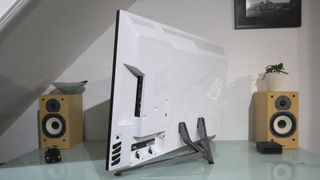
A comprehensive gaming feature set is where the ASUS ROG Strix XG43UQ really scores. The 43-inch panel sports the full 4K, so that’s 3,840 by 2,160 pixels, combined with 144Hz refresh for PC gaming and 120Hz for consoles. The former is enabled via a DisplayPort 1.4 socket while the latter is supported courtesy of a pair of HDMI 2.1 Ports. A further two HDMI ports are included, but only in 2.0 spec, limiting refresh to 60Hz at the native 4K resolution.
Next up, there’s AMD FreeSync Premium Pro certification including full adaptive refresh capability (it’s also compatible with Nvidia’s G-Sync technology and GPUs, it just doesn’t have a G-Sync chip), claimed 1ms response, plus ASUS’s Extreme Low Motion Blur (ELMB) tech. It sure seems like this should be a seriously slick and speedy G-Sync compatible FreeSync monitor.
Of course, HDR is de rigueur for any self-respecting gaming panel these days. But the XG43UQ is a cut above most monitors thanks to DisplayHDR 1000 certification - HDR 400 and 600 are far more common. Among other things, that means peak brightness of fully 1,000 nits and broad colour coverage including 90 percent of the demanding DCI-P3 colour space.
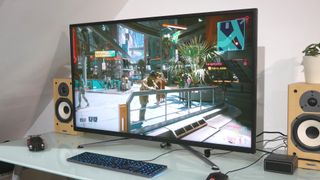
All very impressive. But before we fire this monster up, are there any causes for concern buried in the spec sheet? Well, despite the HDR 1000 certification, this is an edge-lit panel rather than one with a grid of dimming zones. ASUS isn’t quoting the number of edge dimming zones, but it’s almost certainly somewhere in the eight to 16 range. Whatever, an LCD panel with edge-lit backlighting is not the stuff of true HDR performance.
A mitigating factor is the use of a VA rather than IPS panel technology. VA technology can achieve far better inherent contrast and ASUS indeed claims 4,000:1 static contrast which should help boost HDR performance. The best IPS panels top out at around 1,300:1. The catch is that VA panel technology hasn’t always been the best when it comes to pixel response. Hold that thought.
Performance
Lordy, this thing is bright. Painfully, ridiculously, gloriously bright. There’s no way you’d run it at anything like full reheat on a day-to-day basis as a desktop monitor.
On the other hand, the HDR experience is pretty sweet. As expected, the contrast of the VA panel does a pretty good job of making up for the lack of true local dimming. So the retina-searing highs are combined with reasonably deep black levels.
A nice example of this are outdoor urban vistas in Cyberpunk 2077. Sunlit elements of the scene absolutely zing, but without shadows under overpasses washing out. Add in the huge 43-inch proportions plus the epic detail of full 4K visuals, not to mention Nvidia’s ray-tracing and DLSS technologies in full flow with one of the best graphics cards, and it makes for a stunning spectacle and will be great when teamed with one of the best gaming laptops or best gaming PCs. Though this is not a flawless experience.
The main problem is pixel response. The use of a VA panel isn’t necessarily a disaster in terms of response, as Samsung has released a number of really quick VA monitors in the last 12 months, but the ASUS ROG Strix XG43UQ can’t match them. Not even close.
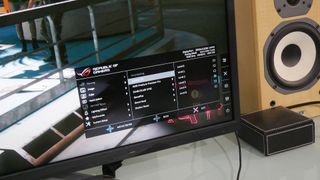
ASUS claims 1ms response performance but uses the MPRT metric rather than grey-to-grey. Whatever the merits of quoting MPRT response, the reality is that this monitor suffers from significant blurring.
ASUS has included five levels of user-configurable overdrive in the OSD menu, enabling fine-tuning of response. However, from level three onwards inverse ghosting becomes a problem. By level five it’s horrific. Unfortunately, ASUS’s ELMB technology is little better. Far from improving things, ELMB just makes a strobe-y, triple-vision mess of everything. Yuck.
To put all this into context, we happen to have a five-year-old 40inch 4K VA Philips monitor in our labs that offers better pixel response. Long story short, the VA panel ASUS has gone for has sufficiently poor inherent pixel response that there’s little that features like pixel overdrive can do to rescue the situation.
In that context, any further flaws are arguably academic. But for the record, the XG43UQ appears to be running at least some image processing that cannot be turned off, resulting in overly sharpened fonts.
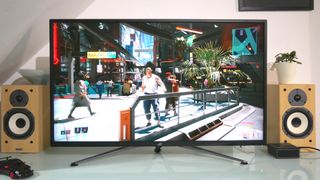
Overall - should you buy it?
At this price point, the ASUS ROG Strix XG43UQ needs to be something special and by some measures, it absolutely is. For sure, it’s one of, if not the, brightest and punchiest monitors we’ve ever seen. Thanks to VA panel tech, it serves up a spectacular HDR experience despite lacking true local dimming capability.
Unfortunately, the wheels fall off when it comes to pixel response. Admittedly, the problem isn’t quite as obvious actually in-game as opposed to eyeballing test images. But it’s still visible. It wouldn’t be good enough on a monitor one-quarter the money, let alone operating at this lofty level. When the likes of a 120Hz OLED panel can be had for a similar budget, it’s awfully hard to recommend something this flawed. Very bright with great 4K detail, but not quite the full ticket
A serious dissertation on the finer points of input lag and overshoot followed by a forensic examination of AI-accelerated temporal upscaling. Such is a routine day in the working life of long-time tech wordsmith, Jeremy Laird. Along with GamesRadar, Jeremy’s 15-year back catalogue includes a host of tech and gaming outlets, including TechRadar and PC Gamer, not to mention contributions to mainstream media from the Independent to the Evening Standard. Complimenting Jeremy’s debilitating addiction to all kinds of digital hardware, he is also afflicted by an obsession with and a significant occupational sideline in cars and automotive technology.

Keanu Reeves is returning for John Wick 5 as the franchise expands with an anime prequel series and a Caine spin-off movie

Ex Nintendo PR managers say the Switch 2 generation is likely to see the retirement of "several of the major developers at Nintendo who we have known for 40 something years"

Helldivers 2 CEO says industry layoffs have seen "very little accountability" from executives who "let go of one third of the company because you made stupid decisions"
